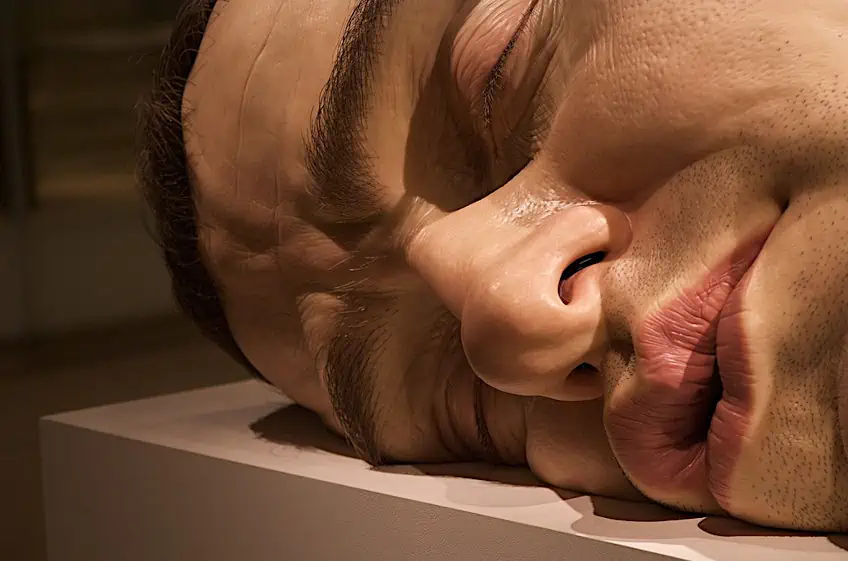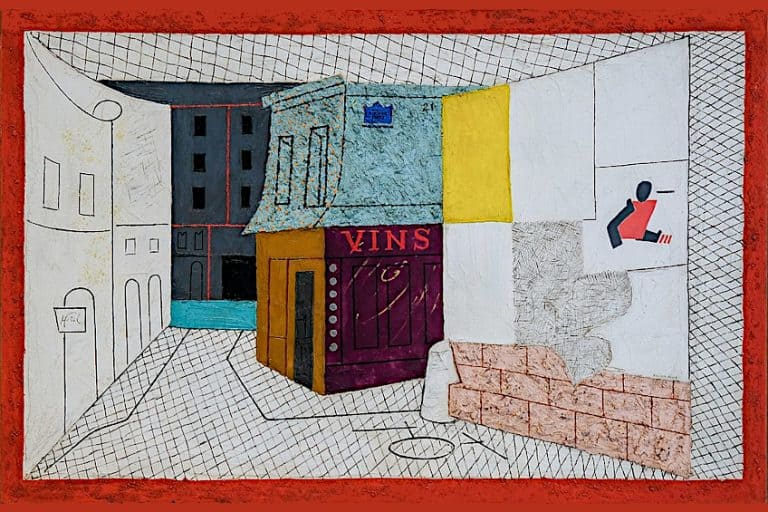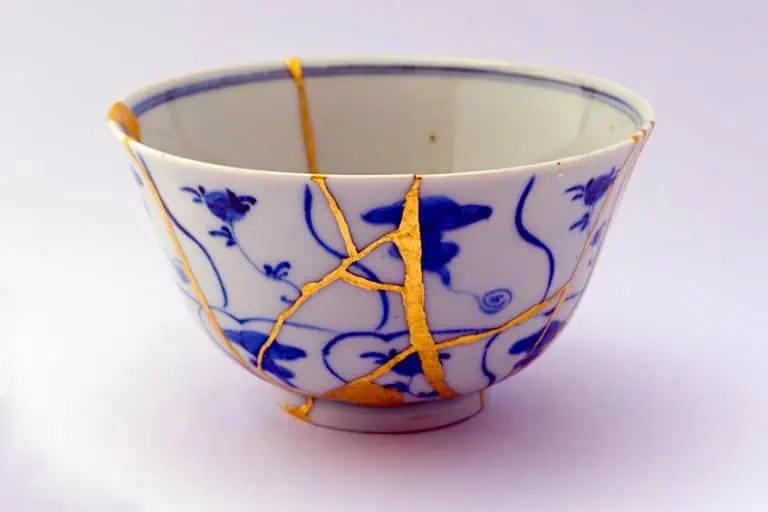Proportion and Scale in Art – How Artists Use Variations in Size
This post may contain affiliate links. We may earn a small commission from purchases made through them, at no additional cost to you.
What is proportion in art and what is scale in art used for? Proportion and scale in art refer to the placement and size of the various elements of an artwork in relation to each other and the viewer. Defined as principles of art, proportion and scale add to the overall harmony or expressiveness of an artwork. Let’s explore the definition of both of these concepts, as well as look at a few proportion in art examples and a few scale in art examples.
Table of Contents
Understanding Proportion and Scale in Art
While both concepts are quite similar, there is a fundamental difference that will help you grasp both concepts more clearly. If you have two people in an artwork and one is an adult and the other is a child, then they should differ in size relative to each other – that is scale. If you have one human then the various limbs and features all need to be the correct size relative to each other – that is proportion.
In art, an object is often referred to as a “whole” – when two wholes differ in size, then they differ in scale. Whereas with proportion, all the elements within the whole are the correct size relative to each other.
Scale can also refer to the actual scale of the artwork relative to the viewer. By playing with scale and proportion an artist can evoke a broad range of viewer responses to an artwork. The scale and proportions can also be manipulated to purposefully distort the elements to convey ideas or feelings.
 Woman looking at The Art of Painting by Johannes Vermeer (c. 1666); piotr iłowiecki from POLAND, CC BY-SA 2.0, via Wikimedia Commons
Woman looking at The Art of Painting by Johannes Vermeer (c. 1666); piotr iłowiecki from POLAND, CC BY-SA 2.0, via Wikimedia Commons
What Is Proportion in Art?
As we have already mentioned, as one of the principles of art, proportion defines the various size relationships of the elements within an object (whole) of an artwork. There are several distinct types of proportion in art: standard, hierarchical, exaggerated, and altered proportion. Let us now take a closer look at each of these types of proportions in art.
Standard Proportion
A standard proportion is one in which the artist applies seemingly correct proportions and sizes for a certain figure in the image. The idea of standard proportion is the subject of much debate, with some artists questioning the existence of such a thing in the first place. Take, for example, the human body; it’s rare to find two individuals who measure exactly the same across all areas of their body. Why try to standardize human body proportions in art if there is no such thing?
 Facial drawing with notes on proportion by Leonardo da Vinci (1489-1490); I, Luc Viatour, Public domain, via Wikimedia Commons
Facial drawing with notes on proportion by Leonardo da Vinci (1489-1490); I, Luc Viatour, Public domain, via Wikimedia Commons
Various studies into human preferences have revealed that irrespective of culture, humans do appear to favor faces and body types that conform to an average norm. In other words, features should not be significantly larger or smaller than the norm, nor should they be asymmetrical. In that sense, the set of proportions most likely to be considered balanced, consists of the most average scaled set of traits relative to one another. The result is that there does appear to be a standard set of human proportions against which we innately judge those of the real and imagined people we see.
Artist will use standard proportion to achieve a sense of calm and universality. It will be less suitable for evoking turmoil, drama, or representations of specific individuals and their psychological states.
Hierarchical Proportion
Hierarchical proportion differs from the above-mentioned standard proportion in that the various aspects of the artwork are scaled in order of decreasing significance. As a result, the most significant elements of the image will be larger and more visible than the less crucial elements. Employing a hierarchical scale works well in works where certain elements must be emphasized more than others.
Artists in various ancient cultures often portrayed gods, rulers, and kings significantly larger than common people when depicting these in the same scene.
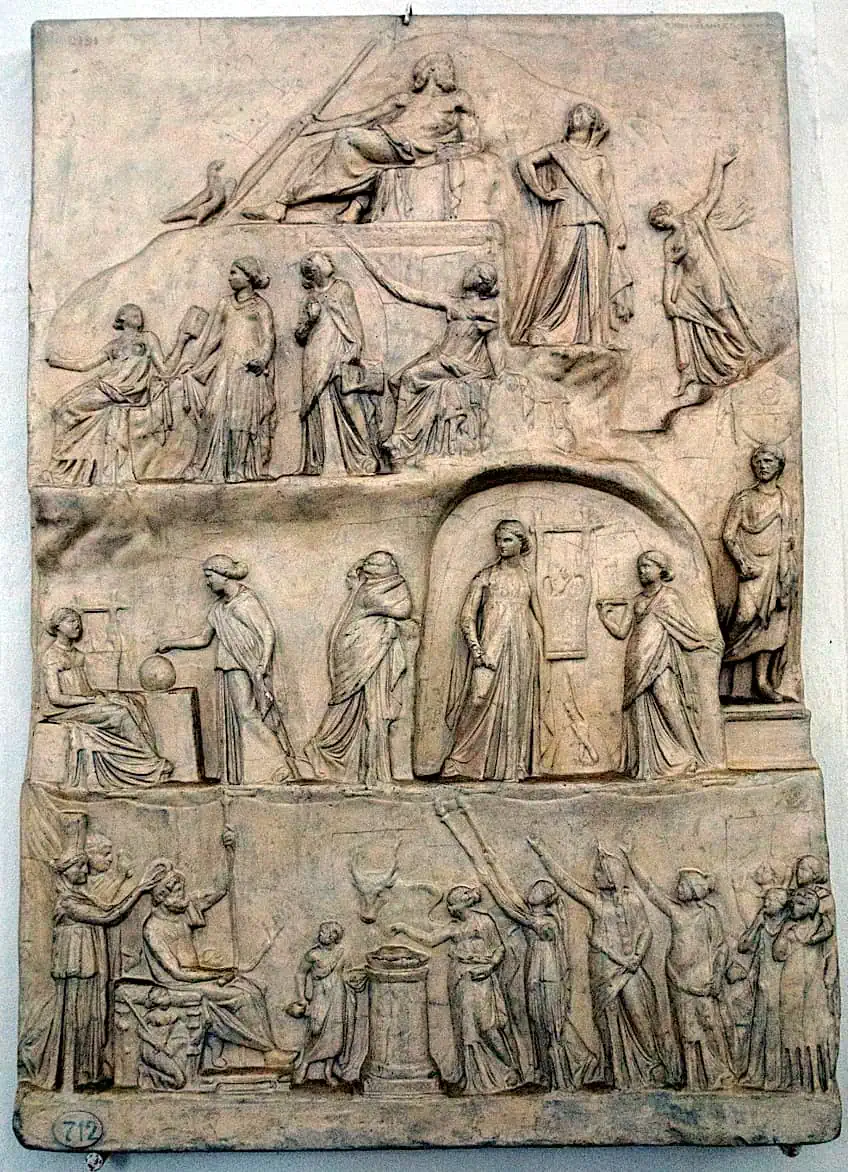 Apotheosis of Homer by Archelaos of Priene (225-205 BCE). Note how much smaller the human worshippers performing the sacrifice are, compared to the deified poet and the gods; Zde, CC BY-SA 4.0, via Wikimedia Commons
Apotheosis of Homer by Archelaos of Priene (225-205 BCE). Note how much smaller the human worshippers performing the sacrifice are, compared to the deified poet and the gods; Zde, CC BY-SA 4.0, via Wikimedia Commons
Exaggerated Proportion
Exaggerated proportions are often characterized as being “out of proportion”. The term refers to an artwork in which two elements possess sizes that do not reflect their interrelationship. A human head depicted four times its normal size, for instance, is significantly blown out of proportion, but it may be useful in delivering the drawing’s meaning to the observer.
Ancient Sumerian sculpture for example, included votive figures given as gifts to the gods that are known for their impossibly large eyes.
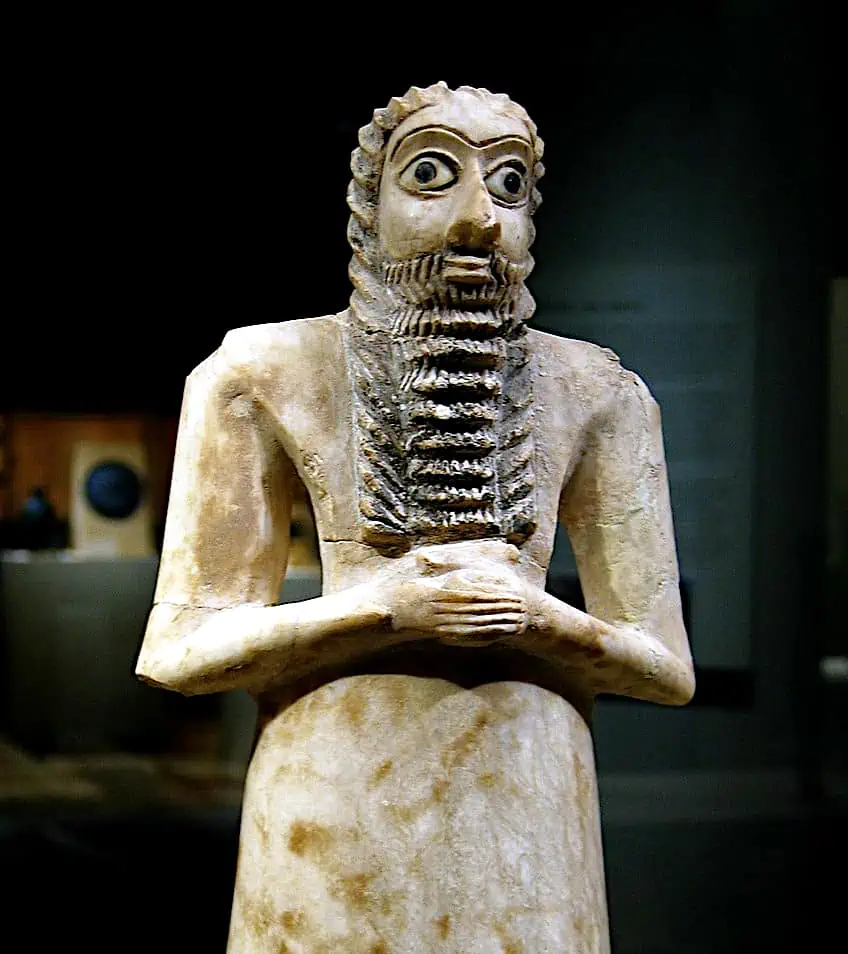 Sumerian male worshipper dedicated to Eshnunna (2750−2600 BCE); Rosemaniakos from Bejing (hometown), CC BY-SA 2.0, via Wikimedia Commons
Sumerian male worshipper dedicated to Eshnunna (2750−2600 BCE); Rosemaniakos from Bejing (hometown), CC BY-SA 2.0, via Wikimedia Commons
Altered Proportion
A purposeful distortion or exaggeration of the relative size, shape, or positioning of distinct elements within an artwork is referred to as altered proportion in art. This style can be used to add drama and intensity to a composition. Throughout history, artists have employed altered proportions in a number of ways.
Ancient Egyptian art favored depiction of humans and gods with their heads and legs in profile and their torsos in frontal view, producing a feeling of equilibrium and poise.
 Painted relief from the tomb of Amenemhet and Hemet (between 1976 and 1794 BCE); Art Institute of Chicago, Public domain, via Wikimedia Commons
Painted relief from the tomb of Amenemhet and Hemet (between 1976 and 1794 BCE); Art Institute of Chicago, Public domain, via Wikimedia Commons
Proportion in Art Examples
Even if you intend to make artworks that defy some proportional principles, you won’t be able to do it effectively until you first learn the rules. When it comes to painting and other kinds of artwork, first understanding how to properly apply proportion is simply essential. When painting realistic objects, the proportions must be carefully calculate in order for the image to appear more natural.
With the discovery of proportion, painters realized what they had been doing incorrectly. Improper proportions in the background and between elements produce a distorted linear perspective, giving their paintings a warped impression of distance. Ironically, creating the illusion of realism requires a great degree of visual manipulation.
To modern viewers, sculpture from the Classical Greek period appears highly naturalistic, and is often lauded as the first example of realism in the development of art. However, the Classical style was based on altering the proportions of the human body in order to create a wholly idealized version of it. For example, the so-called Riace Bronzes (460-450 BCE) appear to be remarkably realistic depictions of adult males. However, anatomists have pointed out features that were altered beyond what is anatomically possible.
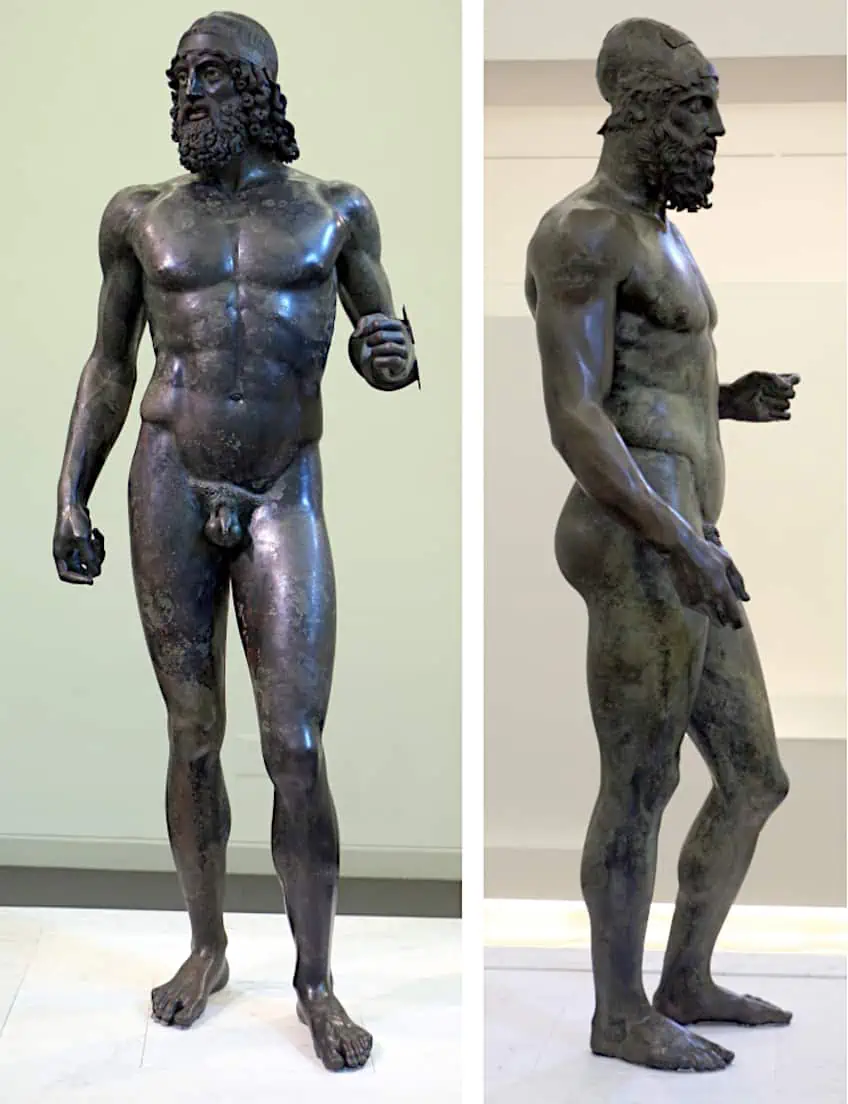 The Riace Bronzes (460-450 BCE): Left Statue A; Sailko, CC BY-SA 4.0, via Wikimedia Commons. Right Statue B; Sailko, CC BY-SA 4.0, via Wikimedia Commons
The Riace Bronzes (460-450 BCE): Left Statue A; Sailko, CC BY-SA 4.0, via Wikimedia Commons. Right Statue B; Sailko, CC BY-SA 4.0, via Wikimedia Commons
Such changes were made to achieve a more visually harmonious appearance. We know this because ancient theorists devised mathematical models based on what they called the “Golden Mean” to produce the perfect set of human proportions. One legendary sculptor was described as creating a work based on observations of multiple models, each of whom possessed the perfect example of a specific feature, to combine into the image of the ideal woman.
This obsession arose from the ancient Greek association of physical beauty with moral rectitude. The word kalos referred not only to physical perfection, but to all that could be considered good, desirable, and beneficial.
By contrast, movements such as Expressionism used clearly identifiable changes in proportion to convey emotions and ideas. For example, in Egon Schiele’s Self-Portrait, Grimacing (1910), the artist has depicted himself in the nude. His physical proportions have clearly been altered by exaggerations of specific features. The use of line and brushstroke further accentuate the convoluted body to reflect a complex psychological state. While this use of intentionally contorted proportion is a feature of Modernism, its precursors can be seen in the work of artists like El Greco (1541-1614) and Hieronymus Bosch (c. 1450-1516).
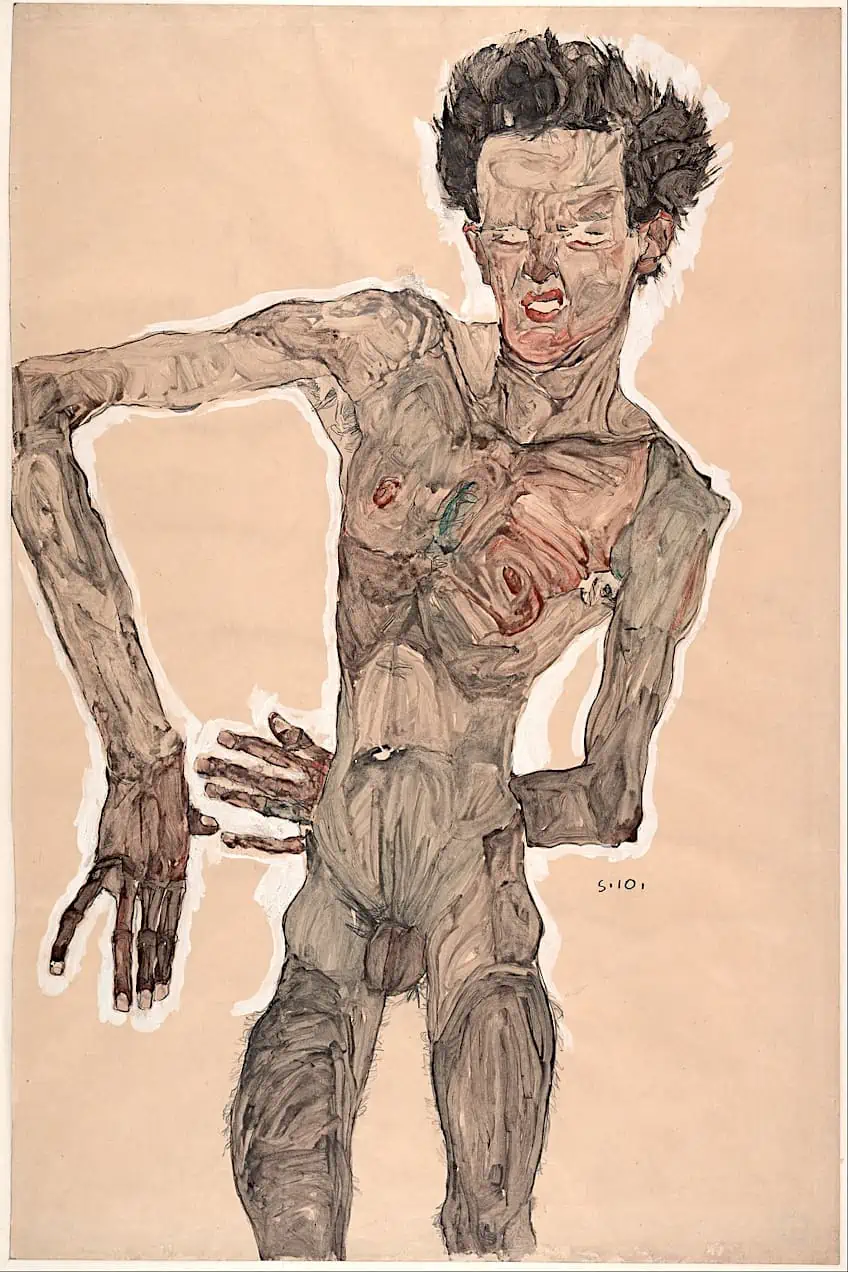 Self-Portrait, Grimacing by Egon Schiele (1910); Egon Schiele, Public domain, via Wikimedia Commons
Self-Portrait, Grimacing by Egon Schiele (1910); Egon Schiele, Public domain, via Wikimedia Commons
What Is Scale in Art?
The size of an object in proportion to its environment or in comparison to other components in the same composition is referred to as scale in art. It can refer to either the actual size of a work of art or the size of pieces inside the artwork. Scale is used by artists in a number of ways to achieve distinct effects and express different ideas. An artist, for instance, may utilize a big scale to create a feeling of majesty and monumentality or to underline the significance of a specific subject or person.
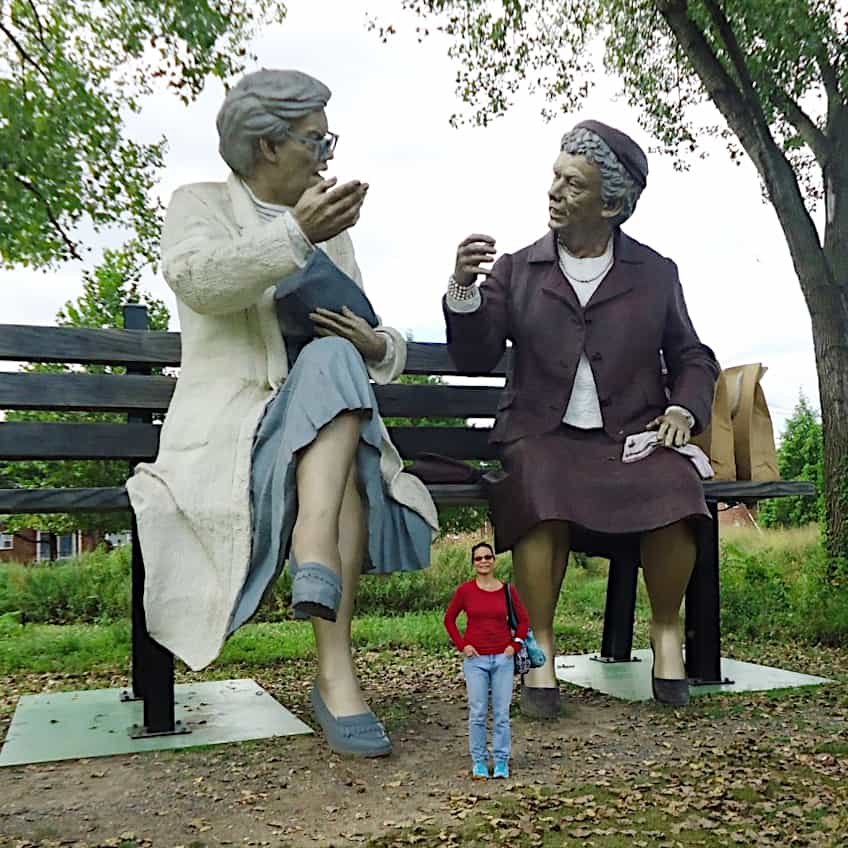 Woman posing in front of Crossing Paths by Seward Johnson (2011); Tomwsulcer, CC0, via Wikimedia Commons
Woman posing in front of Crossing Paths by Seward Johnson (2011); Tomwsulcer, CC0, via Wikimedia Commons
An artist, on the other hand, may employ a small scale to create intimacy or to bring attention to minor details.
Scale can additionally be employed to provide depth to a composition or to represent spatial relationships. An artist could utilize diminishing size to create a sense of distance, or overlap scales to represent layers or planes inside a picture. From paintings and sculptures to architecture and installation art, scale is a major element in all kinds of visual art. Artists can generate a broad range of visual effects and engage audiences in new and surprising ways just by playing around with scale. The three types of scale in art are actual, relative, and representative scale.
Actual Scale in Art
The size of the depiction of an object artwork in relation to its actual size is referred to as its actual scale. A life-size statue of a human figure, for instance, is made to actual scale. Actual scale may be employed in art to give a sense of realism by making the work a direct reproduction of its real-life subject matter.
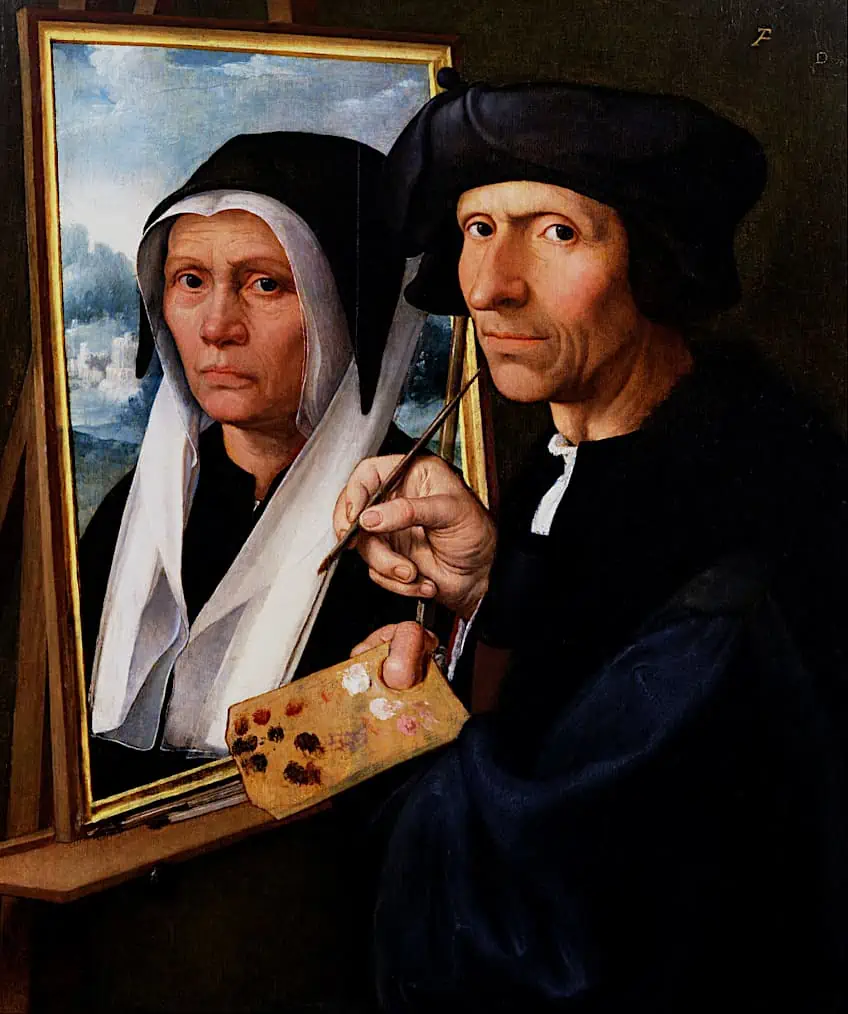 Jacob Cornelisz van Oostsanen Painting a Portrait of His Wife by Dirck Jacobsz (1550); Dirck Jacobsz., Public domain, via Wikimedia Commons
Jacob Cornelisz van Oostsanen Painting a Portrait of His Wife by Dirck Jacobsz (1550); Dirck Jacobsz., Public domain, via Wikimedia Commons
Relative Scale in Art
Relative scale is a technique for creating and determining the spatial location of a figure or object in a three-dimensional image plane. Items or people that are further away are rendered smaller in size than those that are closer to the observer. And objects or figures that are closer are depicted larger. The relative size of an object or figure produces the appearance of space on a flat 2D visual plane in this manner.
 Landscape with the Fall of Icarus attributed to Pieter Brueghel the Elder (between c. 1555 and 1558); Possibly Pieter Brueghel the Elder, Public domain, via Wikimedia Commons
Landscape with the Fall of Icarus attributed to Pieter Brueghel the Elder (between c. 1555 and 1558); Possibly Pieter Brueghel the Elder, Public domain, via Wikimedia Commons
Representative Scale in Art
The application of proportions and sizes in artwork that correctly represent the relative size of things and figures in the actual world is referred to as representational scale in art. This implies that the scale of items and persons in the artwork should be relatively accurate to their real-life size when shown relative to one another.
 Still Life with Game, Vegetables and Fruit by Juan Sánchez Cotán (1602); Juan Sánchez Cotán, Public domain, via Wikimedia Commons
Still Life with Game, Vegetables and Fruit by Juan Sánchez Cotán (1602); Juan Sánchez Cotán, Public domain, via Wikimedia Commons
If an artist is creating a portrait, for instance, they may utilize representative scale to guarantee that the size of the person’s head, torso, and limbs are proportional to the individual’s real dimensions. It would not be a representative scale if the artist painted the person’s head too large or too little in comparison to their body.
Scale in Art Examples
Scale also influences our impression of perspective. When objects are appropriately sized with respect to the perspective, a painting seems three-dimensional. In a landscape, for instance, the size between a distant mountain and a tree in the front should represent the audience’s viewpoint.
The tree is not as massive as the mountain in reality, but because it is closer to the observer, it seems much larger. If the mountain and tree were their actual sizes, the image would lack depth, which is one of the qualities that define outstanding landscapes.
One example of scale in art is the Arnolfini Portrait (1434) by Jan van Eyck. Van Eyck employs scale to create a feeling of depth and perspective in this artwork. The figures in the image are shown in proportion to their real size, and their arrangement in relation to the other objects in the room produces a feeling of spatial depth.
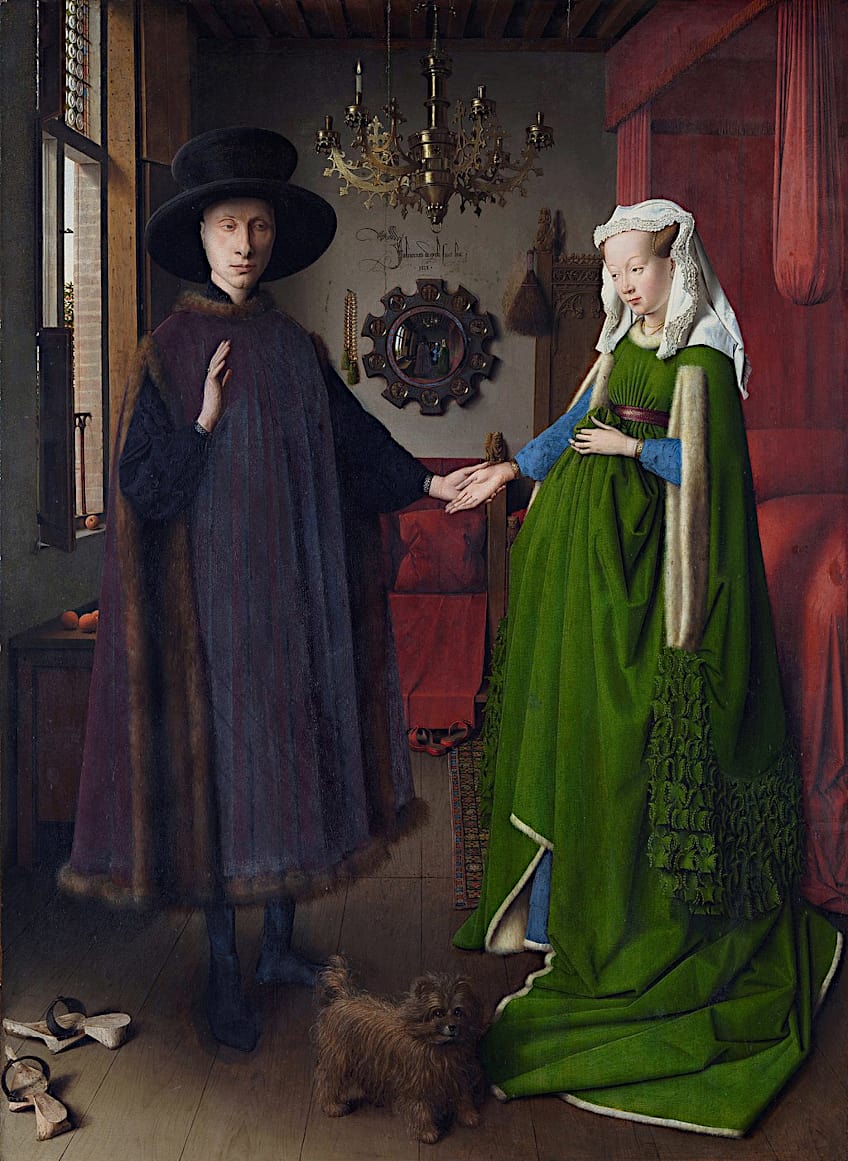 The Arnolfini Portrait by Jan van Eyck (1434); Jan van Eyck, Public domain, via Wikimedia Commons
The Arnolfini Portrait by Jan van Eyck (1434); Jan van Eyck, Public domain, via Wikimedia Commons
The actual size of the artwork relative to the viewer can also have a significant impact on his it is viewed and understood. The hyperrealist sculptor Ron Mueck, for example, combines exceptionally detailed observation of his subjects with massive scale. The result is an artwork that fuses reality with fantasy to allow the viewer to see the subject in a way that that is both compelling and unnerving.
Mueck’s sculpture Mask II (2001-2002) takes this interplay even further when what appears to be a the monumental face of a sleeping man is revealed to be a flimsy mask.
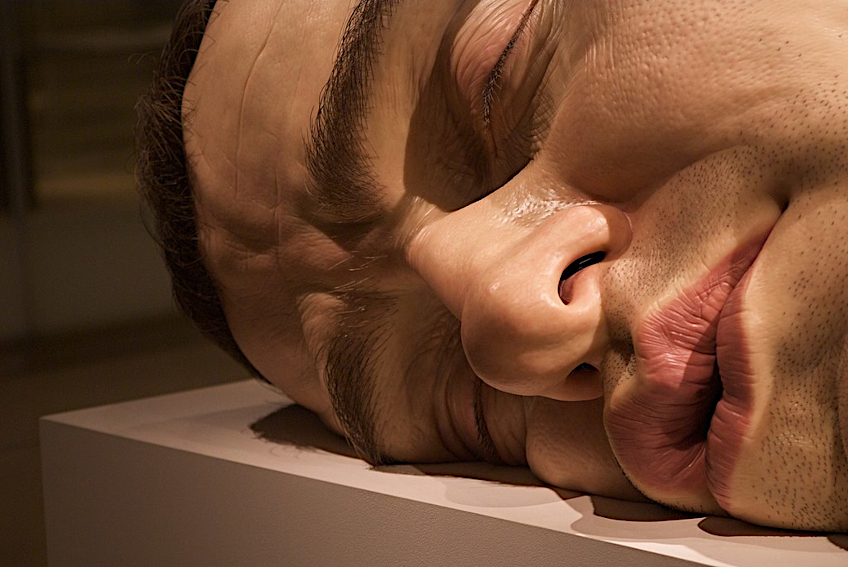 Mask II by Ron Mueck (2001-2002); Paul Hudson from United Kingdom, CC BY 2.0, via Wikimedia Commons
Mask II by Ron Mueck (2001-2002); Paul Hudson from United Kingdom, CC BY 2.0, via Wikimedia Commons
By contrast, Spanish sculptor Isaac Cordal creates miniature figures engaged in a variety of activities that he installs across public spaces. For example, Neighbors (2016) features a set of tiny iron railing balustrades installed on the side of a residential building. A few of the little balconies are occupied by small men either talking on their cellphones or engaged in their own thoughts, evoking a sense of isolation instead of communal living. Cordal works in miniature to reward those who still pay close attention to their physical environments, instead of retreating into virtual worlds.
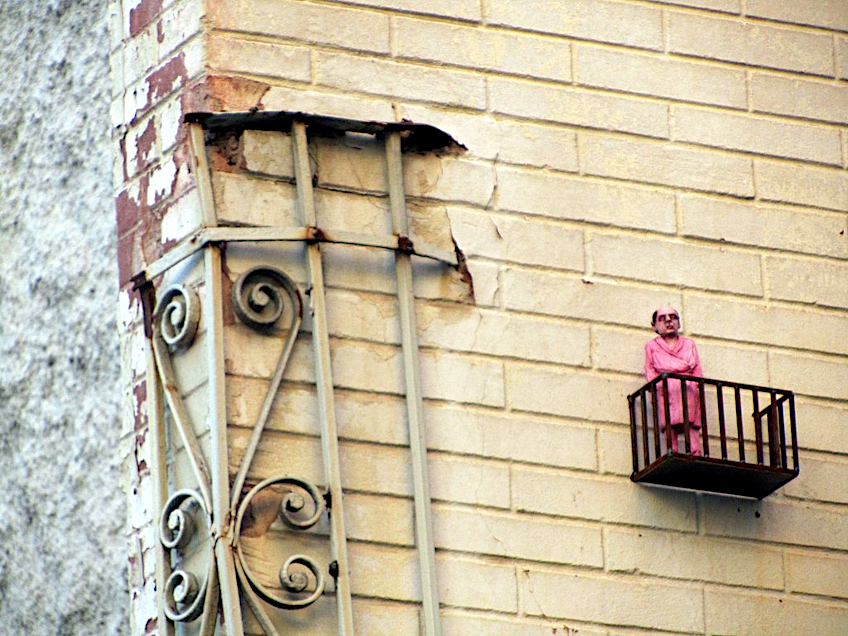 Detail from Neighbors (2016) by Isaac Cordal); Campeones 2008, CC BY-SA 4.0, via Wikimedia Commons
Detail from Neighbors (2016) by Isaac Cordal); Campeones 2008, CC BY-SA 4.0, via Wikimedia Commons
The Importance of Proportion and Scale in Art
Proportion and scale are significant in art because they contribute to a composition’s feeling of harmony, balance, and visual appeal. In order to portray a sense of realism, the proportions of a human body or a building must be realistic. Incorrect proportions can cause a piece of art to appear distorted or unnatural, drawing attention away from its overall impact.
Artists can create a feeling of tension, emphasis, or even humor by adjusting the scale. A little object, for instance, can be made to look larger than life, giving a sensation of awe or veneration.
A massive item, on the other hand, can be made to look little and inconsequential, generating a feeling of comedy or irony. They are also helpful for creating a feeling of depth when the objects in the foreground differ in size from the objects in the background.
The Seven Principles of Art Overview
- Principles of Art Overview
- Balance in Art
- Movement in Art
- Contrast in Art
- Pattern in Art
- Unity and Variety in Art
- Emphasis in Art
The unifying thread between proportion and scale is that they both deal with size. You should keep two things in mind: the connection and the size. Scale is the size connection between one figure and another figure or other elements in the work of art. Proportion is the size relation between one part of an object and another element of the same object.
Frequently Asked Questions
What Is Proportion in Art?
In art, proportion refers to the connection between the sizes of distinct parts within a specific object within a composition, as well as how those sizes relate to one another and to the overall size of the piece. It is concerned with the relative proportions and placements of various aspects of an artwork, and how they add to the piece’s overall aesthetic. In art, proportion is frequently used to convey a sense of realism.
What Is Scale in Art?
Scale can be utilized to provide depth and space to a scene. In a landscape painting, an artist could use scale to create the impression of perspective by making elements in the foreground bigger than those in the background. One could also purposefully distort the scale of things in a composition for artistic impact, such as making a little object look larger than life or a large object seem small and inconsequential.
In 2005, Charlene completed her wellness degrees in therapeutic aromatherapy and reflexology at the International School of Reflexology and Meridian Therapy. She worked for a company offering corporate wellness programs for several years before opening her own therapy practice. In 2015, she was asked by a digital marketer friend to join her company as a content creator, and it was here that she discovered her enthusiasm for writing. Since entering the world of content creation, she has gained a lot of experience over the years writing about various topics such as beauty, health, wellness, travel, crafting, and much more. Due to various circumstances, she had to give up her therapy practice and now works as a freelance writer. Since she is a very creative person and as a balance to writing likes to be active in various areas of art and crafts, the activity at acrylgiessen.com is perfect for her to contribute their knowledge and experience in various creative topics.
Learn more about Charlene Lewis and about us.
